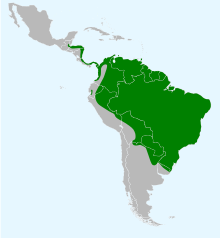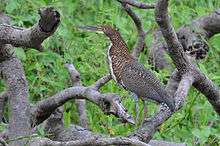Rufescent tiger heron
The rufescent tiger heron (Tigrisoma lineatum) is a species of heron in the family Ardeidae. It is found in wetlands from Central America through much of South America.

_young_adult_head.jpg)
| Rufescent tiger heron | |
|---|---|
| in the Pantanal, Brazil | |
| Scientific classification | |
| Kingdom: | Animalia |
| Phylum: | Chordata |
| Class: | Aves |
| Order: | Pelecaniformes |
| Family: | Ardeidae |
| Genus: | Tigrisoma |
| Species: | T. lineatum |
| Binomial name | |
| Tigrisoma lineatum (Boddaert, 1783) | |
 | |
Taxonomy
The rufescent tiger heron was described by the French polymath Georges-Louis Leclerc, Comte de Buffon in 1780 in his Histoire Naturelle des Oiseaux from a specimen collected in Cayenne, French Guiana.[2] The bird was also illustrated in a hand-coloured plate engraved by François-Nicolas Martinet in the Planches Enluminées D'Histoire Naturelle which was produced under the supervision of Edme-Louis Daubenton to accompany Buffon's text.[3] Neither the plate caption nor Buffon's description included a scientific name but in 1783 the Dutch naturalist Pieter Boddaert coined the binomial name Ardea lineata in his catalogue of the Planches Enluminées.[4] The rufescent tiger heron is now placed in the genus Tigrisoma that was erected by the English naturalist William Swainson in 1827.[5][6] The genus name Tigrisoma combines the Ancient Greek tigris, meaning "tiger" and somā, meaning "body"; the specific epithet lineatum is from the Latin lineatus meaning "marked with lines".[7]
Two subspecies are recognised:[6]
Description
The rufescent tiger heron is a medium-sized heron, measuring 26–30 in (66–76 cm) in length,[nb 1][9] with a mass between 630 and 980 g (22 and 35 oz).[10] The sexes are similarly plumaged.[11] The adult's head, neck and chest are dark rufous, with a white stripe down the center of the foreneck. The remainder of its upperparts are brownish with fine black vermiculations, its belly and vent are buffy-brown, and its flanks are barred black and white.[12] Its tail is black, narrowly barred with white.[13] Its stout bill is yellowish to dusky, and its legs are dull green.[12] Its irides, loral skin and orbital ring are bright yellow.[13] Unlike other tiger herons, it has no powder down feathers on its back.[11]
The juvenile bird is rusty-buff overall, coarsely barred with black; the buff and black banding on its wings is especially pronounced. Its throat, central chest and belly are white. It takes some five years to acquire adult plumage.[12]
Similar species
The adult rufescent tiger heron is relatively easy to distinguish from fasciated and bare-throated tiger herons, as it is rufous (rather than primarily gray) on the head and neck. Young birds, however, are much more difficult to identify.[9]
Distribution and habitat
The rufescent tiger heron is found in wetlands from Central America through much of South America.[12] It generally occurs below 500 m (1,600 ft), though it has been recorded as high as 1,600 m (5,200 ft) in Colombia.[9]
Behavior
It is largely crepuscular and generally solitary.[9][13]
Food and feeding
As might be expected of a species that spends most of its time by the water, much of the rufescent tiger heron's diet is aquatic-based, including fish, crustaceans, water beetles and dragonfly larvae. It also takes adult dragonflies and grasshoppers.[11] It typically hunts alone, standing hunched in shallow pools or wet areas of forest while it waits for prey.[9]
Conservation
Although the rufescent tiger heron's population size and trend has not been quantified, its range is huge, so the International Union for the Conservation of Nature lists it as a species of least concern.[1]
Notes
- By convention, length is measured from the tip of the bill to the tip of the tail on a dead bird (or skin) laid on its back.[8]
References
- BirdLife International (2012). "Tigrisoma lineatum". IUCN Red List of Threatened Species. 2012. Retrieved 26 November 2013.CS1 maint: ref=harv (link)
- Buffon, Georges-Louis Leclerc de (1780). "L'onoré rayé". Histoire Naturelle des Oiseaux (in French). Volume 14. Paris: De L'Imprimerie Royale. pp. 181–182.
- Buffon, Georges-Louis Leclerc de; Martinet, François-Nicolas; Daubenton, Edme-Louis; Daubenton, Louis-Jean-Marie (1765–1783). "L'onoré rayé, de Cayenne". Planches Enluminées D'Histoire Naturelle. Volume 9. Paris: De L'Imprimerie Royale. Plate 860.
- Boddaert, Pieter (1783). Table des planches enluminéez d'histoire naturelle de M. D'Aubenton : avec les denominations de M.M. de Buffon, Brisson, Edwards, Linnaeus et Latham, precedé d'une notice des principaux ouvrages zoologiques enluminés (in French). Utrecht. p. 52, Number 860.
- Swainson, William John (1827). "On several groups and forms in ornithology, not hitherto defined". Zoological Journal. 3: 343-363 [362].
- Gill, Frank; Donsker, David, eds. (2019). "Ibis, spoonbills, herons, hamerkop, shoebill, pelicans". World Bird List Version 9.2. International Ornithologists' Union. Retrieved 16 July 2019.
- Jobling, James A. (2010). The Helm Dictionary of Scientific Bird Names. London: Christopher Helm. pp. 228, 386. ISBN 978-1-4081-2501-4.
- Cramp, Stanley, ed. (1977). Handbook of the Birds of Europe, the Middle East and North Africa: Birds of the Western Palearctic, Volume 1, Ostrich to Ducks. Oxford, UK: Oxford University Press. p. 3. ISBN 978-0-19-857358-6.
- Hilty, Steven L.; Brown, William L. (1986). A Guide to the Birds of Colombia. Princeton, NJ, US: Princeton University Press. p. 67. ISBN 978-0-691-08372-8.
- Dunning Jr., John B. (2008). CRC Handbook of Avian Body Masses (2nd ed.). Boca Raton, FL, US: CRC Press. p. 32. ISBN 978-1-4200-6445-2.
- Hancock, James; Kushlan, James A. (2010). The Herons Handbook. London, UK: A&C Black. ISBN 978-1-4081-3496-2.
- Ridgely, Robert S. (1989). A Guide to the Birds of Panama: With Costa Rica, Nicaragua, and Honduras. Princeton, NJ, US: Princeton University Press. p. 67. ISBN 978-0-691-08529-6.
- Kenefick, Martyn; Restall, Robin; Iayes, Floyd (2007). Birds of Trinidad and Tobago (2nd ed.). London, UK: Christopher Helm. p. 48. ISBN 978-1-4081-5209-6.
External links
| Wikimedia Commons has media related to Tigrisoma lineatum. |
- Rufescent tiger heron photo gallery at VIREO (Drexel University)
- "Rufescent tiger heron media". Internet Bird Collection.
- Audio recordings of Rufescent tiger heron on Xeno-canto.

